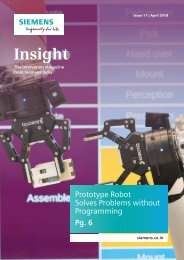Insight_PDF For Web
You also want an ePaper? Increase the reach of your titles
YUMPU automatically turns print PDFs into web optimized ePapers that Google loves.
Transitioning to Semantic Information<br />
“We simply tell the robot to<br />
attach a specific component to<br />
the mounting rail,” says Wurm.<br />
“And that’s exactly what it<br />
does.” On a small scale, this<br />
task describes what batch size 1<br />
is all about. It involves<br />
manufacturing or assembling a<br />
product in a wide variety of<br />
variants that contain different<br />
components. The robot gets<br />
the information on how to<br />
manufacture a product from an<br />
associated software model.<br />
Although this CAD/CAM<br />
(Computer Aided Design and<br />
Manufacturing) model is<br />
incomprehensible for<br />
conventional robots, the new<br />
prototype can understand such<br />
models. In a sense, it is as if the<br />
robot can understand different<br />
languages, thus eliminating the<br />
need to program its<br />
movements and processes.<br />
To do this, the prototype<br />
successively divides tasks, such<br />
as the general command<br />
“assemble,” from the software<br />
construction plan into doable<br />
units, such as “pick” and “hand<br />
over” until it finally moves an<br />
arm or opens its grippers. The<br />
robot itself also decides which<br />
task each arm should perform.<br />
To make this possible, the<br />
developers have enabled the<br />
prototype to raise information<br />
from the product development<br />
software to a semantic level.<br />
“Product parts and process<br />
information are semantically<br />
converted into ontologies and<br />
knowledge graphs,” says Wurm.<br />
“This makes implicit information<br />
explicit. Until now the<br />
A great objective: With their research, Georg Wichert (left) and Kai Wurm have demonstrated that<br />
economical batch size 1 production is possible.<br />
things that people simply know from<br />
experience when they are told to snap<br />
component X onto rail Y have had to be<br />
taught to robots in the form of code.<br />
However, our prototype analyzes the<br />
problem by itself and finds a corresponding<br />
solution.”<br />
In the case of Siemens’ prototype<br />
demonstrator, one can witness this<br />
process in a vastly simplified form on a<br />
monitor to the right of the robot arms.<br />
The monitor displays two rows of color<br />
tiles, each of which bears words such as<br />
“assemble” (left-hand column) and “pick”<br />
(right-hand column). These tiles gradually<br />
move upward in a manner similar to<br />
scrolling down a long webpage. The tiles<br />
depict each assembly step. On the<br />
monitor to the left, the demonstrator<br />
shows the information that the robot<br />
arms receive at the beginning of a<br />
production process. This information<br />
consists of a 3D depiction of the<br />
surrounding area and the objects it<br />
contains. Above the demonstrator are two<br />
more screens that show what the robot<br />
arms are currently seeing through their<br />
integrated cameras.<br />
Toward Self-Correcting Systems<br />
Siemens Corporate Technologies’<br />
prototype system can also<br />
correct faults without having to<br />
be told beforehand that this is<br />
an option. If a part slips, for<br />
example, one of its arms will<br />
find the part as long as it is<br />
within its camera’s field of<br />
vision. The arm will then pick<br />
up the component and adjust<br />
all of its subsequent movements<br />
so that it can still install<br />
it correctly. And if the component<br />
needs to be snapped into<br />
place on the other side of an<br />
assembly, the arm will hand the component<br />
to its counterpart. These groundbreaking<br />
developments are part of the<br />
Company Core Technology (CCT) Future<br />
of Automation program. CCTs enable<br />
Siemens to focus on crucial fields of<br />
innovation such as digital twins, artificial<br />
intelligence, and additive manufacturing.<br />
Naturally, assembling control cabinets is<br />
just the beginning. Siemens developers<br />
envision self-organizing production<br />
facilities that responds to autonomously<br />
changing production requirements,<br />
continuously optimize their operations,<br />
and are populated by robots that assist<br />
one another. Such facilities would be a<br />
revolutionary step – essentially systems<br />
that feed themselves with design data,<br />
corrects faults, and calculates all movements<br />
and actions on their own. “There<br />
are many other researchers who are trying<br />
to solve this problem. But there is nothing<br />
comparable to what we have developed<br />
on the market yet,” says Wurm.<br />
• Sandra Zistl<br />
Taken from Pictures of the Future, the Siemens<br />
Magazine for Research and Innovation<br />
<strong>For</strong> more information,<br />
write to insight.in@siemens.com<br />
7



